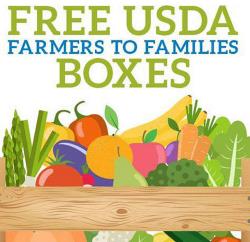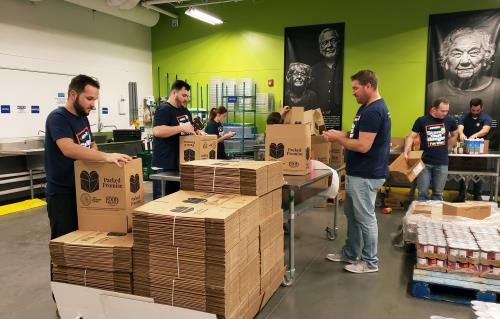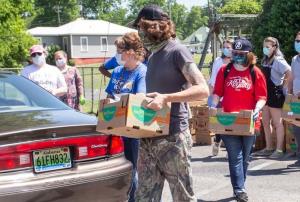The Farmers to Families Food Box program was initiated in haste in response to market disruptions caused by COVID-19. The program was  conceived by Secretary of Agriculture Dr. Sonny Perdue in response to the fact that there was an accumulation of produce and other agricultural products on farms and a pressing need to alleviate hunger among families that had lost income. The initial program was funded at approximately $2.7 billion and an additional extension of $1 billion was recently approved using emergency authority.
conceived by Secretary of Agriculture Dr. Sonny Perdue in response to the fact that there was an accumulation of produce and other agricultural products on farms and a pressing need to alleviate hunger among families that had lost income. The initial program was funded at approximately $2.7 billion and an additional extension of $1 billion was recently approved using emergency authority.
The plan was for USDA to select contractors to source produce and assemble the food boxes with distribution to food banks and faith-based organizations to be supplied to those in need. It is understood that as many as 75 million boxes have been distributed.
The program was recently reviewed by journalists Jessica Fu and H. Claire Brown, followed by an article in The Counter. This non-profit organization investigates social issues and although considered somewhat left-of-center many of the findings have been confirmed by mainstream media.
 Despite the self-congratulatory releases by USDA and personal visits by Secretary Perdue to distribution centers it is apparent that the program has operated with inadequate oversight and control. As with many hastily implemented projects the Farmers to Families Box initiative is associated with wastage and possibly fraud. The program was the subject of an acrimonious hearing by the House Agriculture Sub-committee on Nutrition, Oversight and Department Operations on July 31st in which the chairperson Representative Marcia L. Fudge (D-OH) castigated the responsible Undersecretary of Agriculture for lack of oversight.
Despite the self-congratulatory releases by USDA and personal visits by Secretary Perdue to distribution centers it is apparent that the program has operated with inadequate oversight and control. As with many hastily implemented projects the Farmers to Families Box initiative is associated with wastage and possibly fraud. The program was the subject of an acrimonious hearing by the House Agriculture Sub-committee on Nutrition, Oversight and Department Operations on July 31st in which the chairperson Representative Marcia L. Fudge (D-OH) castigated the responsible Undersecretary of Agriculture for lack of oversight.
A statement issued subsequent to the hearing included:-
Because USDA has rushed this program out the door, there is very little quality control with regard to who gets these contracts and who is qualified to actually meet the need. Tens of millions of dollars have gone to inexperienced contractors that still haven’t delivered anywhere near what they’ve promised.
 The article in The Counter notes that boxes distributed in Puerto Rico, assembled by a Caribbean produce exchange cost as much as $100 per unit. Commentators with experience in handling and distribution of produce claim that the cost to taxpayers represents a three-fold overcharge. There were numerous complaints regarding quality of products packed and their selection. Nationwide over 200 contractors were involved in the program many of whom had no experience in sourcing and assembling boxes. Recipient agencies including food banks were underwhelmed by service and quality. Informed observers consider that the approximately $3.7 billion expended would have been more beneficial had it been injected into the Supplementary Nutrition Assistance Program using existing mechanisms and allowing recipients to directly purchase what they needed for their families by selecting from participating groceries and supermarkets.
The article in The Counter notes that boxes distributed in Puerto Rico, assembled by a Caribbean produce exchange cost as much as $100 per unit. Commentators with experience in handling and distribution of produce claim that the cost to taxpayers represents a three-fold overcharge. There were numerous complaints regarding quality of products packed and their selection. Nationwide over 200 contractors were involved in the program many of whom had no experience in sourcing and assembling boxes. Recipient agencies including food banks were underwhelmed by service and quality. Informed observers consider that the approximately $3.7 billion expended would have been more beneficial had it been injected into the Supplementary Nutrition Assistance Program using existing mechanisms and allowing recipients to directly purchase what they needed for their families by selecting from participating groceries and supermarkets.
While the program has benefited both farmers and those subjected to hunger, a considerable amount of taxpayer money was wasted through insufficient planning and oversight. It is hoped that lessons will have been learned from the exercise.